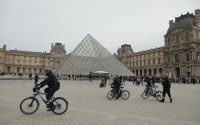Controversial Demolition of Mary Miss Installation Reaches ‘Unsatisfying Status Quo’ After Court Ruling
The fate of an outdoor installation by artist Mary Miss installed at the Des Moines Art Center (DMAC) is still undecided, even after a preliminary injunction blocking its demolition was issued by an Iowa court on Friday.
Judge Stephen Locher of the US District Court for the Southern District of Iowa concurred with the artist’s claim that, as outlined in her contract with the museum, her Land artwork Greenwood Pond: Double Site (1996) cannot be demolished without her permission. Locher, however, also determined that the contract allows the museum the right to refuse repairing the installation if a judge deems the cost too expensive.
The museum has estimated that the cost of repairs surpasses $2.6 million. Miss has disputed this figure.
Through this new ruling, the DMAC cannot begin the demolition, but Miss also cannot force the museum to repair the work. “The end result is therefore an unsatisfying status quo: the artwork will remain standing (for now) despite being in a condition that no one likes but that the court cannot order anyone to change,” Locher wrote.
In a statement, Miss praised the judge’s decision, saying, “I am grateful for Judge Locher’s ruling, and I hope this opens the door to the consultations about the future of the site that were denied me.”
A DMAC spokesperson said, “We are exploring our options as to how to resolve what has become a court-ordered stalemate. In the meantime, we will retain the existing fencing around the dangerous sections of the site and will engage the City of Des Moines to address public safety in Greenwood Park.”
In April, Miss filed a lawsuit to prevent the demolition of the installation at the DMAC, which the museum commissioned but claims is unsalvageable after years of decay.
Miss had been pursuing a temporary restraining order against the museum to halt the demolition of the work. The suit called for the DMAC to honor its 1994 contract with Miss, and accused the institution of violating the Visual Artists Rights Act (VARA) of 1990 through the “destruction of a work of recognized stature, and any intentional or grossly negligent destruction of that work.”
The installation was intended to dialogue with the wetlands of Greenwood park. A series of pathways (variably made of wood, cement, steel, and granite) intersect the park, offering museumgoers an intimate view of the ecosystem. Miss has described the installation as “an outdoor classroom.”
In January, the museum’s board sent a letter to Miss, informing her that the structure had eroded and that reengineering it was “not financially feasible.” The letter cited previous repairs on Greenwood Pond completed in 2014, a process that its engineers said would only extend its life for another decade. The letter also cited Miss’s previous acknowledgment that the work may need to be deinstalled by 2012.
In a public statement issued on April 4, the DMAC noted that an internal structural review found “a recurring pattern of structural, operational, and material problems dating back to 1996 that made the artwork vulnerable to decay, erosion, regular seasonal fluctuations, and extreme weather-related events, such as floods.”
This information “was sobering, and it prompted a serious moment of reckoning,” the statement added.



